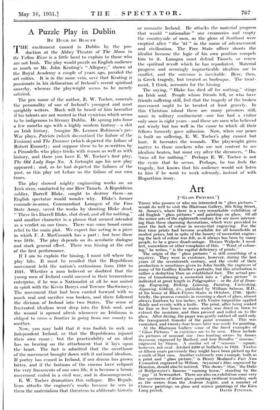Art
[" CLASS PICTURES: 'j THOSE who possess or who are interested in " glass pictures " would do well to visit the Blairman Gallery, 26a King Street, St. James's, where there is a very remarkable exhibition of old English " glass pictures " and paintings on glass. Of all the minor arts of the eighteenth century few are more interest- ing than these charming decorations, which were provided to meet the lack of colour in mezzo-tint engraving. For the first time prints had become available for all households at modest prices, but in spite of the beauty of mezzotint engrav- ing the lack of colour was felt, as it always has been by many people, to be a grave disadvantage. Horace Walpole, I recol- lect, somewhere or other complains of this. " Want of colour- ing," he writes, " is the capital deficiency of prints."
The origin of the " glass pictures " is still something of a mystery. They were in existence, however, during the last years of the seventeenth century, and the credit of their production is sometimes given to John Smith, the engraver of many of Sir Godfrey Kneller's portraits, but this attribution is rather a deduction than an established fact. The actual pro- cess of transforming a mezzotint into a " glass picture " is indicated at great length in Polygraphice : or the Art of Draw- ing, Engraving, Etching, Limning, Painting, Varnishing, Japaning, Gilding, d'c., published by William Salmon, M.D., at his house at Black-Fryers Stairs in October, 1700. Quite briefly, the process consists in covering a sheet of glass, almost . always fourteen by ten inches, with Venice turpentine applied thinly and evenly with a knife. The print, after being soaked for four or five hours in warm water, was dried on linen to extract the moisture, and then pressed and rolled on to the glass. After drying, the paper was gently rubbed off until only the transparent transfer of the paint remained. This was varnished, and twenty-four hours later was ready for painting. At the Blairman Gallery some of the finest examples of " Glass Pictures " in existence are to be seen. These include six pictures of unusual size—two hunting scenes by James Seymour, engraved by Barford, and four Rosalba " seasons," engraved by Simon. A similar set of " seasons "—square, however, not oval—fetched £300 at Sothebys in 1928. Twelve or fifteen years previously they might have been picked up for a sixth of that sum. Another extremely rare example, both as a print and " glass picture," is Henry Morland's Fair Nun Unmasked, engraved by Wilson. Seymour's Star, engraved by Houston, should also be noticed. This shows " Star," the Duke of Bridgewater's famous " running horse," standing by the
gap " at Newmarket. There are also on exhibition some very . fine specimens of direct glass painting (without transfer), such as the scenes from the Arabian Nights, and a number of Chinese paintings on glass and mirror paintings of the Kieft


















































 Previous page
Previous page